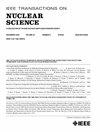空间辐射监测用超宽动态范围读出专用集成电路的研制
IF 1.9
3区 工程技术
Q3 ENGINEERING, ELECTRICAL & ELECTRONIC
引用次数: 0
摘要
已经开发了一套用于空间辐射监测的半导体探测器的读出专用集成电路(asic),包括模拟前端(WDDose-AFE)芯片和带波形采样模数转换器(ADC)的数字信号处理(WDDose-DSP)芯片。WDDose-AFE芯片包括一个前置放大器,随后是整形器的多增益级和每个通道的全差分输出缓冲器。WDDose-DSP芯片集成了一个10位和100 MSPS的逐次逼近寄存器(SAR) ADC、一个数字梯形滤波器和每个通道的峰值检测逻辑。WDDose-AFE和WDDose-DSP的原型芯片分别在180 nm和65 nm的CMOS上制备。WDDose-AFE和WDDose-DSP的单通道功耗仅为13.6和11.3 mW。WDDose-AFE低增益级的输入动态范围可达4.4 pC,高增益级的等效噪声电荷(ENC)小于1200e $^{-}$,输入电容为50-pF。用硅探测器、电子束和离子束对ASIC芯片进行了测量。详细的电路设计和测试结果将在本文中给出。本文章由计算机程序翻译,如有差异,请以英文原文为准。
Development of Ultrawide Dynamic Range Readout ASICs for Radiation Monitoring in Space
A set of readout application-specific integrated circuits (ASICs) has been developed for semiconductor detectors for space radiation monitoring, including an analog front-end (WDDose-AFE) chip and a digital signal-processing (WDDose-DSP) chip with a waveform sampling analog-to-digital converter (ADC). The WDDose-AFE chip consists of a preamplifier, followed by multigain stages of shapers and fully differential output buffers for each channel. The WDDose-DSP chip integrates a successive approximation register (SAR) ADC in 10-bit and 100 MSPS, a digital trapezoidal filter, and peaking detection logic for each channel. The prototype chips of WDDose-AFE and WDDose-DSP were fabricated in 180- and 65-nm CMOS, respectively. The single-channel power consumptions of WDDose-AFE and WDDose-DSP were measured to be only 13.6 and 11.3 mW. The input dynamic range of WDDose-AFE was up to 4.4 pC for the low-gain stage, while the equivalent noise charge (ENC) was less than 1200e $^{-}$ for the high-gain stage with 50-pF input capacitance. The ASIC chips were also measured with silicon detectors and electron and ion beams. The detailed circuit design and test results will be presented in this article.
求助全文
通过发布文献求助,成功后即可免费获取论文全文。
去求助
来源期刊

IEEE Transactions on Nuclear Science
工程技术-工程:电子与电气
CiteScore
3.70
自引率
27.80%
发文量
314
审稿时长
6.2 months
期刊介绍:
The IEEE Transactions on Nuclear Science is a publication of the IEEE Nuclear and Plasma Sciences Society. It is viewed as the primary source of technical information in many of the areas it covers. As judged by JCR impact factor, TNS consistently ranks in the top five journals in the category of Nuclear Science & Technology. It has one of the higher immediacy indices, indicating that the information it publishes is viewed as timely, and has a relatively long citation half-life, indicating that the published information also is viewed as valuable for a number of years.
The IEEE Transactions on Nuclear Science is published bimonthly. Its scope includes all aspects of the theory and application of nuclear science and engineering. It focuses on instrumentation for the detection and measurement of ionizing radiation; particle accelerators and their controls; nuclear medicine and its application; effects of radiation on materials, components, and systems; reactor instrumentation and controls; and measurement of radiation in space.
 求助内容:
求助内容: 应助结果提醒方式:
应助结果提醒方式:


